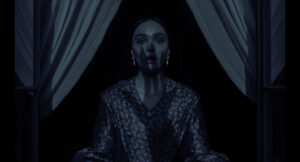Daughters of the Dust
Bridgette Bates
Earlier this week, a newly restored print of writer/director Julie Dash’s vibrant homage to her Gullah ancestors, Daughters of the Dust, screened at the Egyptian Theatre as part of the “From the Collection” program. The Collection is a partnership between Sundance Institute and the UCLA Film and Television Archive to provide an archive devoted to both preserving and offering access to indie films that might have otherwise disappeared.
Visually stunning and impressionistic in style, it’s no wonder Daughters of the Dust won the 1991 Festival’s Excellence in Cinematography Award. The film beautifully weaves together the fragmented history of a family and a place—in 1902, a family gathers on South Carolina’s Sea Islands to bid farewell to their home, a place isolated from the mainland where the descendents of African slaves struggled to maintain their unique lifestyle.
After the screening, author/filmmaker/critic Nelson George joined Dash to discuss her film, which was also selected to be preserved by the Library of Congress in 2004 because of its cultural significance.
RELATED STORIES
Celebrating Black Women Directors: 11 Sundance Institute-Supported Artists to Know
With ‘The 40-Year-Old Version,’ Radha Blank Reconfigures the Indie Film Canon
George: What do you remember about your original screening at Sundance?
Dash: I remember that it was beautiful, but at the time people were saying ‘Hmmm… that’s not like a film I’m used to seeing here. It doesn’t seem familiar. What is that?’ It was kind-of mixed, which is always good because you want to do things that provoke, confound, but more importantly soar the imagination.
George: What is your reaction to this restoration?
Dash: For me, there’s so much I see into the details – it looks like it did when we were editing it. We had great editors, Amy Carey and Joseph Burton, and you forget. But Janice Allen [from Cinema Arts] worked with Arthur Jafa [the film’s cinematographer] on the film 20 years ago, and then they got together again with the help of Chris Horak at the UCLA Archives and with more work now it’s back to where it’s supposed to be.
George: You grew up in a household with this [Gullah] culture around you even though you grew up in New York City. What’s the journey from there as a child to you deciding to make the film?
Dash: Once I decided I was going to tell stories through film, and once I decided that I was not going to be a documentary filmmaker, but I was going to tell narrative stories (because I was excited about the literature of Alice Walker and Toni Morrison and all the poets of the time), I decided that I wanted to tell a story that was authentic to African American culture—authentic to the point where it was not like something you could turn on the television and see. I wanted it to be more like a foreign film and so deeply into the culture that it appeared to be foreign.
Nelson: (Referencing Dash’s early short film work.) You had a black and white film that was a great story about the real [black] singer behind [white] Hollywood singers. You were already thinking about how to re-conceptualize American history.
Dash: When you’re doing it, you’re not really thinking ‘I’m going to sit down and re-conceptualize American history and I’m going to rewrite this and redefine and reimagine.’ I just had the need to say that, and to express that. I thought it was fascinating and the more research I was able to do I realized this was incredible stuff no on has ever touched upon. I just wanted to show this from a different point of view like the Wizard of Oz man behind the curtain.
Nelson: (Returning to Daughters of the Dust.) Watching the film, there’s a lot of dialogue about what do we keep and what do we let go, which your film really centers around. That dialogue never seems to end.
Dash: Exactly. It’s a universal dialogue and the theme is really universal because in every family, there is a great grandmother or grandfather who doesn’t want the younger folks to go away. They have to go away because life is about growth and change. It’s about how you do it—is it an elevated transition or is it a rough passing? In every culture this happens.




